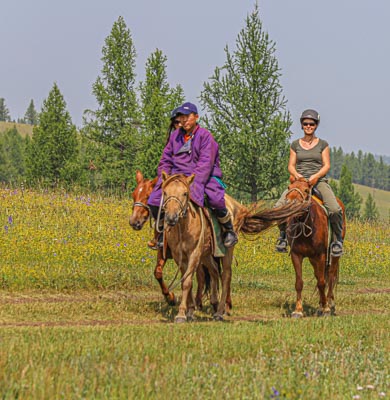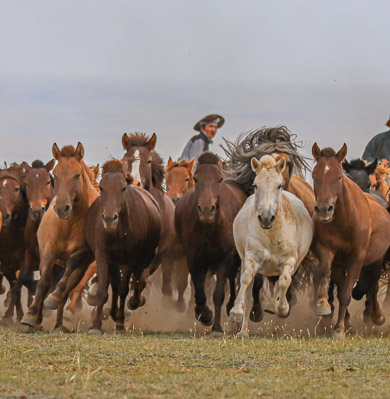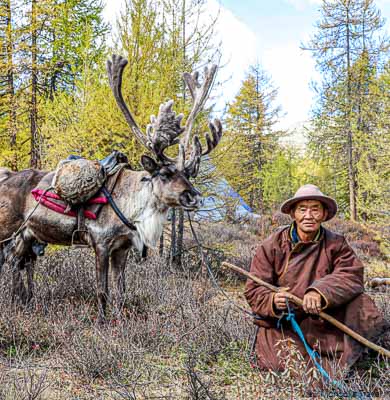1. Mongolian horses outnumber the human population
Mongolia has 4.09.3000 horses, which outnumbers the human population of 3.350.000.
2. Mongolian horse has extraordinary strength, endurance, and stamina
All year round, Mongolian horses graze outdoor in the temperature range between -42°C in winter and +40°C in summer. They endure all types of contrast weather, roaming freely on steppes, sheltering mountain valleys in snowstorms, hoof snow layers to uncover dried grass for self-feed, and drinking snow water. The harsh weather and half wild life of Mongolian horse boosts their strength and stamina. They carry a rider for 65 to 80 km in a day and could gallop with a rider for 30 km without slowing down.
3. Famous Mongolian drink fermented mare milk
Kumis or fermented mare milk Airag is the most famous beverage in Mongolia. It is not just a drink, which can raise your thirst. The Airag is rich in vitamins to add nutrients to diets, sometimes used for medicinal purposes and even possible to substitute meals. Although, the Airag season is short between 20 June and 20 September.
4. Mongolian horse costs tens to hundreds of thousands of United States Dollars
Mongolian horses cost thousands of United States Dollars due to the popularity of horse racing, as well as Mongolian men boast their nice-looking speedy steeds. The state Naadam Festival horse race champion horse costs the highest - 245.000$ to 280.000$. The horses born from the same mare or father horse as the champion horses cost 35.000$ to 70.000$ although they have not won any race. The province Naadam champions cost between 7000$ and 14.000$, while ordinary horses for daily transport and work cost approximately 530$.
5. Few Mongolian horses live long
The average lifespan of a domesticated horse is 25 to 30 years. However, very few horses, such as race champion horses or sanctified horses live long in Mongolia. The reason why Mongolian horses do not live long might break the hearts of the horse lovers. The Mongolian herders breed livestock/horses to support their livelihood rather than enjoyment as the nomads’ life is self-sufficient on their animals. Therefore, they trade and slaughter the animals before they get too old.
6. A person who owns numerous horses
Mr. Onon. D has over 2000 horses. He is originally from Sergelen soum, Tuv province, now herds his horses in eastern grasslands of Dornod province, the most suitable pastureland for horses.
7. Horse skull on the mountains
When you travel to Mongolia, you will see some horse skulls near Ovoos/carns, ceremonial sites on mountain/hilltops. For Mongolians, the horse is a heavenly creature that symbolizes luck, strength, and speed. Therefore, when someone’s loved horse or racehorse die, their owners put the horse heads on a mountain top or at the "ovoo" worshipping site believing that their loved creatures stay closer to the heaven/sky and remain in their heart forever.
8. Vietnam to Mongolia
There is a story about a horse that ran from Vietnam to Mongolia.
The story is: In 1961, Mongolia sent some horses to Vietnam on a train as gifts. Among the horses were 2 spectacularly nice-looking dark brown and brown horses. They acted unfriendly to the other horses and the soldiers, who were looking after them. Upon arrival in Vietnam, the two horses escaped jumping over a tall fence built to keep the horses. The soldiers captured the brown horse, but not the dark brown horse.
Later in 1963, the nomad horse equestrian saw that his dark brown horse returned home.
That was is a story a Mongolian horse returned its country traveling across the other countries. Indeed, several stories exist about horses that came back their herds after being sold hundreds to thousands of kilometers away.
9. The tallest equestrian statue in the world
The 40 m tall Genghis Khan equestrian statue is the tallest equestrian statue in the world. The statue is located 55 km to the east of Ulaanbaatar, an appropriate day trip destination.
10. Mongolian horse race in winter
Mongolian horse racing is held in winter in the open field. Although, the racing distance is much shorter, around 15 to 18 km, compared to the summer horse race distance of 14 to 28 km, depending on the horse age.
11. Mongolians always mount a horse from the left side
Mongolians train the horses to be approached and mounted from the left side. If you try to ride a horse from the right side, the horse will feel uncomfortable and behave badly.
12. Horse racing is a famous Mongolian sport
Horse racing is the most famous Mongolian sport. The horse trainers and jockeys wait for a year around. Among many horse races held in each corner of Mongolia throughout the year, the horse race of Ulaanbaatar Naadam Festival, known as the state Naadam Festival is the most famous as the best of best horses from all over Mongolia compete. Winner horses and winner horse trainers are titled while the jockeys get sports master degrees.
13. Mongolian horse name
In truth, Mongolian horses have no given name, or there is no need to call them by name because the horses rarely stay around home. Instead, the nomads can identify the horses by color or appearance. Mongolians identify their horses by 500-600 colors and appearances. Among the world's 250 types of horses, Mongolian horses are the most diverse in color.
14. Pony station
The origin of the modern postal system, the information delivery by a horse rider dates back to 209 BC Hunnu Empire. Later at the Great Mongolia Empire, Ugudei Khan (1186-1241) decreed to organize permanent horse stations as postal stations and initially established 37 pony stations. The stations were located 40 to 50 km in between, a distance Mongolia horse can cover at a speedy pace with a rider. Upon the rider's arrival at a station, the next rider had to start his journey carrying messages or parcels to the next station. The message/parcel could be delivered 400 to 480 km in a day.
15. Silver horse tack
As pastoral nomads, Mongolian herders do not own many material possessions except the mobile dwelling ger, a few necessary items, and livestock.
Therefore, Mongolians ride well-groomed, nice-looking horses and the same color good-looking horses for a couple, especially on national holidays. Having horse tacks decorated with silver adds happiness to the celebrations of Mongolians.
16. Mongolians learn to ride at the age of 3.
The same as the worldwide children love pets, Mongolian children love their animals, particularly horses. Mongolian children want to learn to ride a horse like their older brothers, sisters, parents, and grandparents. Their parents, in particular, their fathers wish their sons to grow strong and healthy - become prominent riders and good equestrians. Moreover, the nomadic children are in charge of the sheep herd let Mongolian children learn to ride at the age of 3, 4, and 5 years.
17. Stallion-leaded half-wild Mongolian horse herd
The stallions are in charge of the herd rather than the equestrians because Mongolian horses spend more than 9 months or the whole year in the wild, besides a small number of riding animals. The nomads know their horse herd pastureland location and randomly check them. Therefore, the stallions manage their group, keeping the herd number and fighting against wolves, etc. The herd size usually consists of 15 to 70 horses. Some of the herds stay near the nomads’ ger when mares are milked for the famous Mongolian drink Airag between 20 June and 20 September.
18. A horse is depicted on the state emblem of Mongolia
A combination of wind horse (treasure steed) and Soyombo symbol is depicted in the center of Mongolian State Emblem, symbolizing independence, sovereignty, and vivacity.


